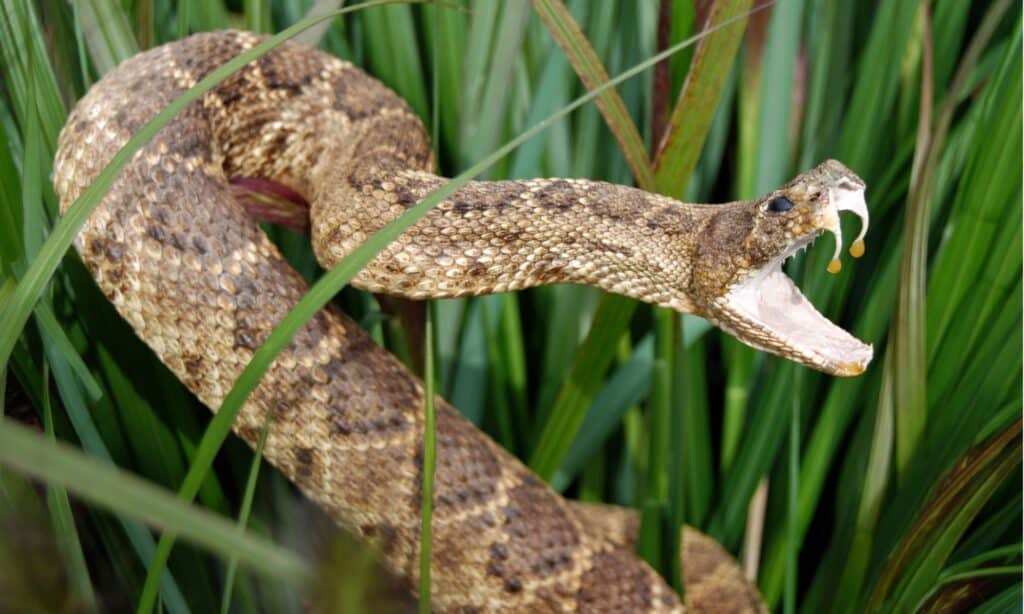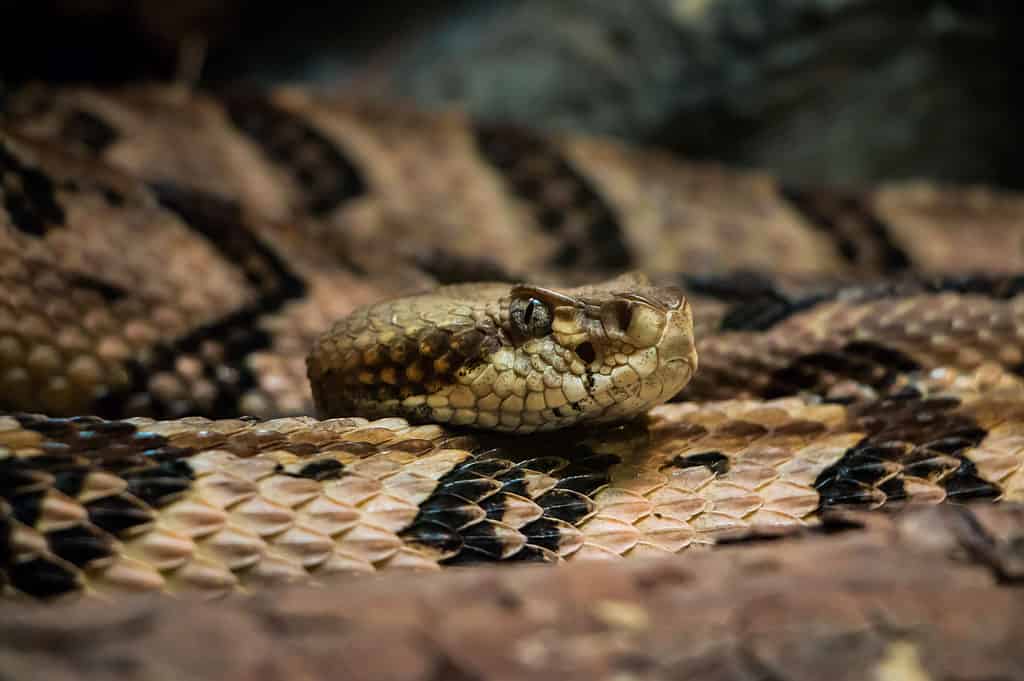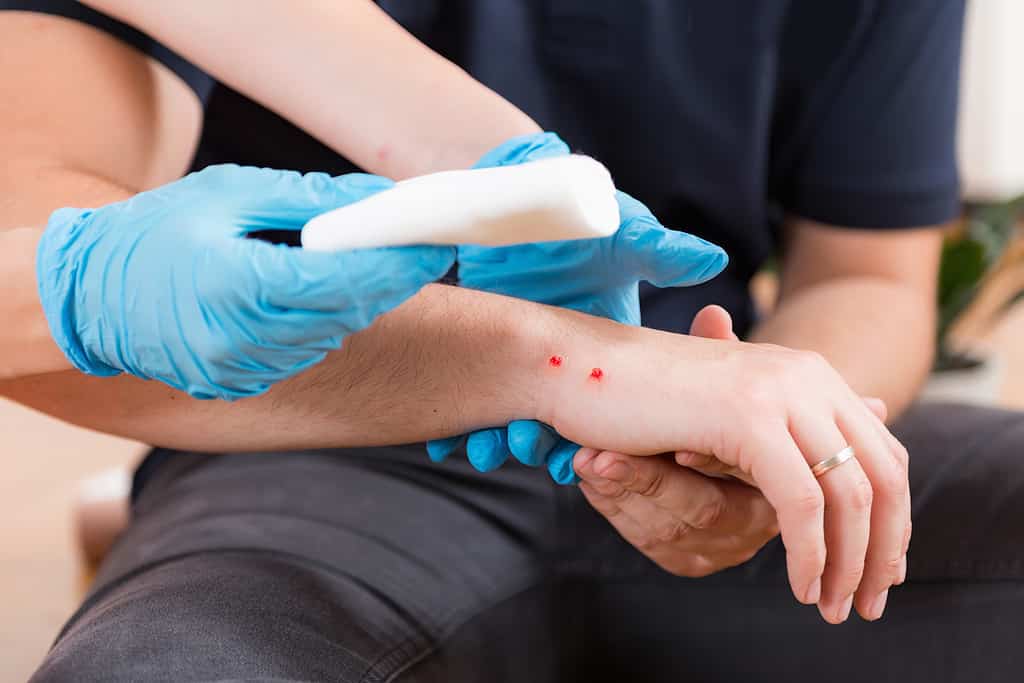The United States has some 30 venomous snake species. Almost every state is home to at least one venomous snake, excluding Hawaii, Maine, Rhode Island, and Alaska. While there may be more than 30 species and subspecies across the country, they can be organized into four main categories. These categories are rattlesnakes, cottonmouths, copperheads, and coral snakes. All four categories of venomous snakes can be found in Mississippi and Florida, which are both states known for their natural beauty and diverse wildlife. Discover which state is home to more venomous snake species and find out what subspecies exist.
What Makes Some Snakes Venomous?

Over time snake enzymes evolved to become more and more toxic.
©iStock.com/liveslow
Snake venom, or poison, originates in organs that developed from salivary glands. Saliva in snakes creates, like that of humans, enzymes. Enzymes are substances in the body that act as catalysts, bringing about biochemical reactions. In humans, enzymes in our saliva help us digest and breakdown our food. On the other hand, some snakes have enzymes that are more toxic, which help to produce venom.
Why do snakes have toxic enzymes? It’s all thanks to evolution. Scientists that have studied snake venom discovered that toxic enzymes in snake saliva are a result of small modifications over time. It’s likely that prey of snakes became gradually more immune to toxins and snake bites. Thus, snake enzymes evolved to become more and more toxic, allowing venomous snakes to attack and kill prey that once were immune to snake poison.
Furthermore, some toxic enzymes in snake saliva result in different effects on prey. While one toxin might block nerve transmission, another can break down muscle tissue. Enzymes can also result in blood vessel leakage or in an alteration of heartbeat rhythm. Venomous snakes can control the amount of venom they inject into prey, too. For instance, the black mamba will inject a dose measuring 12 times the lethal dose when trying to kill a human.
Venomous Snakes in Mississippi

Eastern copperheads can be found in Mississippi and are identified by a pattern of dark brown crossbands shaped like hourglasses.
©Jeff W. Jarrett/Shutterstock.com
There are a variety of venomous snake species in Mississippi, and each species varies greatly in coloration, size, and venom toxicity level. For instance, eastern copperheads have a light gray or beige coloration with a pattern characterized by dark brown crossbands. These crossbands are shaped like hourglasses that have been laid on their side. Juvenile eastern copperheads are born with a bright yellow tail. As eastern copperheads age, their bright yellow tail will fade.
Another venomous snake species in Mississippi, the northern cottonmouth, appears darker with brown, black, or a brownish green or yellow coloration. This species has darker crossbands than the eastern copperhead. Northern cottonmouths record an average length between two and a half and four feet. Like the eastern copperhead, juvenile northern cottonmouths have a bright yellow tail. Other common names for northern cottonmouths include “water moccasins” or “stump-tailed moccasins.”
The pygmy rattlesnake in Mississippi is smaller than the eastern copperhead and northern cottonmouth. It grows to an average length measuring between 18 and 20 inches. The pygmy rattlesnake has dark spots, and its coloration is typically a light or dark gray with an orange dorsal stripe broken by its pattern. Another common name for this snake species is the “ground rattler.” However, the term “ground rattler” is also used to describe some non-venomous snakes native to Mississippi. Therefore, people should be careful in identifying any ground rattler as the formidable pygmy rattlesnake. Pygmy rattlesnakes are best identified by the crown of their head. The crown has nine scales that form a symmetrical pattern.
| Type of Snake | Most Active | Likelihood of Human Encounter | Venom Toxicity Level |
|---|---|---|---|
| Eastern copperhead | Late afternoon and evening | Common; will likely flee from humans | Low; venom is rarely fatal |
| Northern cottonmouth | Day and night; most active after sunset when temperatures are warm | Common; especially common near bodies of water | Somewhat low; more toxic than the copperhead |
| Pygmy rattlesnake | Daytime; most active in the evening when temperatures are warm | Rare | Very low; venom is not life-threatening, but it is painful |
Venomous Snakes in Florida

The Florida cottonmouth is native to Florida and as they age may turn completely black with little visible pattern.
©iStock.com/Saddako
Southern copperheads can be encountered in Florida. This species has a light brown or tan coloration with similar hourglass crossbands as the those of the eastern copperhead. Juvenile southern copperheads also have the same bright yellow tail as juvenile eastern copperheads. Southern copperheads are native to other states, too, such as Texas.
The Florida cottonmouth is native to southern Georgia and Florida. Like the northern cottonmouth, this species is also referred to as a water moccasin. Florida cottonmouths have a lighter coloration, which is usually brown, than that of northern cottonmouths. The Florida cottonmouth has dark brown crossbands, but as Florida cottonmouths age, their coloration may turn completely black with little visible pattern.
Florida is also home to the dusky pygmy rattlesnake. The dusky pygmy rattlesnake has a larger range of size than Mississippi’s pygmy rattlesnake. This species can grow to lengths between 12 and 24 inches. The coloration of the dusky pygmy rattlesnake is light or dark gray with dark spots. However, the dusky pygmy has something that the pygmy rattlesnake does not. The dusky pygmy has a long rust-colored stripe than runs down its back, which disrupts its spotted pattern.
| Type of Snake | Most Active | Likelihood of Human Encounter | Venom Toxicity Level |
|---|---|---|---|
| Southern copperhead | Daytime, especially during early spring and late fall | Common along the panhandle | Low; venom is rarely fatal |
| Florida cottonmouth | Evening and night | Common | Medium; 17% mortality rate if bite is left untreated |
| Dusky pygmy rattlesnake | Early morning and evening | Somewhat common | Very low; venom is not life-threatening, but it is painful |
Venomous Snakes in Both Mississippi and Florida

The canebrake rattlesnake can be found in both Mississippi and Florida and has black zig-zag-shaped crossbands.
©Dennis Riabchenko/Shutterstock.com
A snake native to both states is the eastern diamondback rattlesnake. The eastern diamondback is the largest venomous snake in Mississippi and Florida, measuring between four and five and a half feet on average. Although, some eastern diamondbacks can record a maximum length of eight feet. Coloration of the eastern diamondback is tan or brown, and this species has dark spots that are shaped like diamonds.
Unfortunately, eastern diamondback populations are dwindling. Factors such as habitat fragmentation, habitat loss, and human interference with rattlesnake populations make this species threatened. Therefore, humans that encounter eastern diamondback rattlesnakes should be sure to leave them alone and to treat them with respect.
The canebrake rattlesnake, also known as the timber rattlesnake, the banded rattlesnake, or the “timber rattler,” also resides in Mississippi and Florida. Canebrake rattlesnakes typically grow to lengths between three and four and a half feet. Coloration of the canebrake is gray or tan, and these snakes have black, zig-zag-shaped crossbands. Some people mistakenly refer to canebrake rattlesnakes as diamondbacks. However, canebrakes have both a shorter length and a smaller head than diamondbacks.
Finally, eastern coral snakes are a venomous snake in Mississippi and Florida. Eastern coral snakes measure between two and three feet in length. Unlike other venomous snakes in these states, eastern coral snakes have a brighter, more diversified coloration. Eastern coral snake coloration is characterized by red and black bands that are separated by smaller yellow bands, making them easy to identify. Many people do not know that eastern coral snakes are venomous because they look like scarlet kingsnakes, which are non-venomous. Eastern coral snakes are venomous, but bites from this snake species are extremely rare.
| Type of Snake | Most Active | Likelihood of Human Encounter | Venom Toxicity Level |
|---|---|---|---|
| Eastern diamondback rattlesnake | Daylight | Somewhat common; will likely flee from humans | Medium; 10% to 20% mortality rate if bite is left untreated |
| Canebrake rattlesnake | Daytime; most active in the evening when temperatures are warm | Common | High; venom is very dangerous to humans |
| Eastern coral snake | Daytime | Rare | Low; nearly 10% mortality rate if bite is left untreated |
Which State Has More Venomous Snakes?
Mississippi and Florida have the same amount of venomous snake species. While many assume Florida to have more venomous snake species due to its subtropical climate and diverse wildlife, this is not true. Both states are home to six venomous snake species.
What Happens if I Encounter a Venomous Snake?
Since venomous snake species have a wide distribution across the United States, it’s likely that you might run into one. Whether on a hike, kayaking, camping, or doing any outdoor activity, being able to identify these species and to remain calm is crucial. To avoid stumbling across a venomous snake, people should take some precautions. Below lists some ways to reduce the chance of venomous snake bites.
- Wear long pants, long socks, or boots in areas where venomous snakes might be present. This way, the ankles will not be exposed to being bitten.
- Walk and place hands carefully and watchfully, in case a snake lurks nearby.
- Use a flashlight after sunset for better visibility.
- Stay away from thick brush, caves, woodpiles, or riverbanks.
- If a venomous snake is spotted, back away carefully and do not disturb it.
- Do not touch or bother dead snakes.
- Bring a buddy on a hike or a walk where venomous snakes might be present. This way, if one person is bitten, the other person can call for help.
- Be cautious near trees or in bodies of water; snakes are often present in these areas.
How Common are Venomous Snake Bites in Mississippi and Florida?

Snakebites that receive medical attention will almost never result in death.
©Microgen/Shutterstock.com
Across the United States, no more than 8,000 people are bitten by venomous snakes every year. Of these thousands of bites, only five bites result in fatality. On average, around 100 snakebites are treated annually in Mississippi. Of these bites, 60% are a result of a copperhead encounter, 30% are from cottonmouths, and only 10% are from rattlesnakes. In Florida, approximately 300 venomous snakebites occur each year. Deaths due to venomous snakebites in Florida are not common.
Perhaps surprisingly, many venomous snakebites that occur the United States do not contain venom. Since venomous snakes can control how much venom they inject into a victim, sometimes they choose not to inject any. In fact, between 25% and 50% of venomous snakebite occurrences record no evidence of venom injection. In addition, snakebites that receive medical attention will almost never result in death. Less than 1% of snakebites that receive medical treatment result in fatality.
While the likelihood of death from a venomous snakebite in Florida and Mississippi is low when treated, there are some emergency steps to take when a venomous snakebite occurs. If you or someone you know is bitten by a venomous snake, the following steps are important to remember.
- Don’t panic, and don’t allow the victim to panic. Call for help.
- Remove bracelets, rings, or other items that restrict blood flow.
- Ensure that the bitten area is positioned at or slightly below heart level.
- Keep the bitten area still.
- Wash the bitten area.
- Take the victim to a hospital or other medical treatment facility as soon as possible.
- CPR may be necessary to revive the victim.
- Be ready to treat the victim for shock.
- Do not treat the bitten area with ice, electric shock, or drugs.
- Do not make cuts in or around the bitten area.
- Do not give food or water to the victim by mouth.
- Do not try to “suck out the venom” by placing mouth over the bitten area.
The photo featured at the top of this post is ©
Discover the "Monster" Snake 5X Bigger than an Anaconda
Every day A-Z Animals sends out some of the most incredible facts in the world from our free newsletter. Want to discover the 10 most beautiful snakes in the world, a "snake island" where you're never more than 3 feet from danger, or a "monster" snake 5X larger than an anaconda? Then sign up right now and you'll start receiving our daily newsletter absolutely free.
Thank you for reading! Have some feedback for us? Contact the AZ Animals editorial team.






